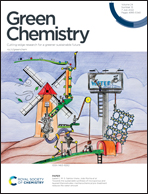Evaluating the mechanism of milk protein as an efficient lignin blocker for boosting the enzymatic hydrolysis of lignocellulosic substrates†
Abstract
The residual lignin in pretreated biomass significantly hinders the bio-conversion of cellulose into monosaccharides. In this work, a low-cost non-enzymatic protein from defatted milk was proposed to block the lignin–enzyme adsorption sites for improving the enzymatic digestibility of diluted acid pretreated bamboo residues (DAP-BR). The enzymatic hydrolysis results showed that the sugar yield significantly improved from 45.8% to 94.6% with a protein dosage of 100 mg−1 glucan. Fractions of surface lignin (SL) and residual lignin (MWL) from pretreated biomass were obtained and used to investigate the effects of milk protein on the interactions between lignin and enzymes by fluorescence emission spectroscopy and surface plasmon resonance (SPR). The fluorescence emission results showed that the addition of protein dramatically decreased the quenching efficiency of lignin fractions for cellulase. The SPR results revealed that milk protein decreased the non-productive absorption between lignin fractions and the enzyme, which showed better performance for intervening in the interaction between DAP-MWL and cellulase than that for DAP-SL. In addition, strong interactions between cellulase and lignin fractions of DAP-SL (ΔGbind = −139.01 kJ mol−1) were demonstrated by a dynamic molecular simulation. In conclusion, this work highlights the potential utilization of low-cost milk to achieve an economically viable biorefinery.



 Please wait while we load your content...
Please wait while we load your content...